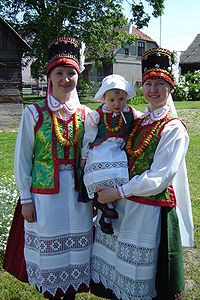Kurpie
Populated areas in Kurpie today are generally in the towns of Myszyniec and Ostrołęka and the villages of Czarnia, Dylewo, Jednorożec, Kadzidło, Lipniki, Łyse and Zbójna.
Traditional Kurpie homes were made out of timber and thatched, with crosses or flags mounted on a gable roof.
The roof's fascia and bargeboards often featured carved decorative ornaments, and were usually topped with heads of animals at the ridge.
In 1927, Adam Chetnik established an open-air museum in Nowogród which showcases traditional Kurpie homes and other elements of their culture.
For example, in the north, women wore red skirts with a green vest over a white linen blouse with some trim and always a necklace made of amber.
During this season, Kurpies delighted in making tall Easter Sunday palms out of small trees and decorating them with flowers and other ornaments in order to protect their houses from ghosts.
Women placed hay under the table and children wandered the streets and sang Christmas carols in return for treats.
Over one thousand original Kurpie songs were recorded by the Polish priest, Władysław Skierkowski, in his book "Puszcza Kurpiowska w pieśni".
A vivid account of the Kurpie region and its people during the 17th-century Swedish invasion can be found in the beginning of Chapter 55 of Henryk Sienkiewicz’s "The Deluge."
Sienkiewicz dramatically describes the personal characteristics and activity of the Kurpie people in Chapters XX and XXI of his historical novel "The Teutonic Knights":



